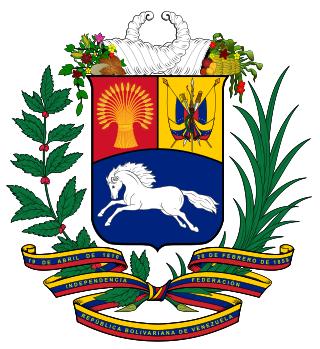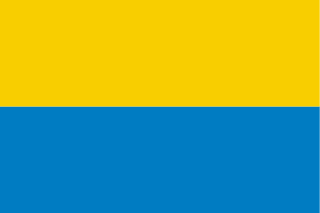
The national flag of Ecuador, which consists of horizontal bands of yellow, blue and red, was first adopted by law in 1835 and later on 26 September 1860. The design of the current flag was finalized in 1900 with the addition of the coat of arms in the center of the flag. Before using the yellow, blue and red tricolor, Ecuador's former flag had three light blue stripes and two white stripes with three white stars for each province of the country.The design of the flag is very similar to those of Colombia and Venezuela, which are also former constituent territories of Gran Colombia. All three are based on a proposal by Venezuelan General Francisco de Miranda, which was adopted by Venezuela in 1811 and later Gran Colombia with some modifications. There is a variant of the flag that does not contain the coat of arms that is used by the merchant marine. This flag matches Colombia's in every aspect, but Colombia uses a different design when her merchant marine ships are at sail.

The coat of arms of Colombia contains a shield with numerous symbols. Perched on top of the shield is an Andean condor holding an olive crown and the condor symbolizing freedom. The national motto, Libertad y Orden, is on a scroll in between the bird and the shield in black font over golden background. The condor is depicted as displayed and looking to the right.

The flag of Delaware consists of a buff-colored diamond on a field of colonial blue, with the coat of arms of the state of Delaware inside the diamond. Below the diamond, the date December 7, 1787, declares the day on which Delaware became the first state to ratify the United States Constitution. The colors of the flag reflect the colors of the uniform of General George Washington.

Quindío is a department of Colombia. It's located in the western central of the country, specifically in the Andean region. Its capital is Armenia. It's famous for the quality of the coffee plantations, colorful architecture, benign weather, variety of hotel accommodations and tourist landmarks. This department is located in a strategic area, in the center of the triangle formed by the three main cities of the country: Bogotá, Medellín and Cali. Quindío is the second-smallest Colombian department with 12 municipalities. Ethnographically and culturally, it belongs to the Paisa region.

The current coat of arms of Venezuela was primarily approved by the Congress on April 18, 1836, undergoing small modifications through history, reaching the present version.

The Emblem of Iraq since the rule of Baathism features a golden black eagle looking towards the viewer's left dexter. The eagle is the Eagle of Saladin associated with 20th-century pan-Arabism, bearing a shield of the Iraqi flag, and holding a scroll below with the Arabic words جمهورية العراق.

The Coat of arms of Peru is the national symbolic emblem of Peru. Four variants are used: the Coat of arms per se ; the National Coat of arms, or National Shield ; the Great Seal of the State ; and the Naval Coat of arms.
The island nation of Malta has a variety of national flags and symbols, some current and some no longer in use.

The coat of arms of Ecuador in its current form was established in 1900 based on an older version of 1845.

The coat of arms of the Department of Bolívar is the official coat of arms of the Department of Bolívar. The coat of arms had been in used before 1856, but in that year the Sovereign State of Bolívar was created, and its symbols changed; the new coat of arms, would be the same as the coat of arms of Colombia but with a red oval around it, that read “ESTADO SOBERANO DE BOLIVAR”. In 1886 the states were suppressed and departments created instead, the symbols were used once again but the originals were corrupted and so there are some variations on the current coat of arms, and that which was specified on the blazon.

The Flora of Colombia is characterized by over 32,000 species of green plants.

The civil flag that serves as the symbol of the state of Mecklenburg-Vorpommern, Germany, consists of five horizontal stripes, that are from the top to bottom: blue (ultramarine), white, yellow, white, and red (vermilion). It was designed by Norbert Buske and adopted on 29 January 1991. It is a combination of the historical flags of the Mecklenburg and Western Pomerania.

The flag that serves as the symbol of the historical and geographical region of the Upper Silesia, and as one of the symbols of the Silesian people, is divided horizontally into two stripes: yellow on the top and blue on the bottom. It originated as the flag of the Province of Upper Silesia adopted in 1920, with its colours based on the coat of arms of Upper Silesia. The flag is also popular symbol used by the Silesian Autonomy Movement.

The coat of arms of Gran Colombia was adopted in 1821.

The flag that serves as the symbol of the historical and geographical region of the Western Pomerania is divided horizontally into two stripes: light blue on the top and white on the bottom. It originated as the flag of the Province of Pomerania, Prussia, used from 1882 to 1935. Since 1996, it is officially recognized as the symbol of the historical region of Western Pomerania within Mecklenburg–Western Pomerania, Germany.

The flag of the president of Colombia consists, like the flag of Colombia, of a rectangle in yellow, blue and red triband in a 2:1:1 ratio, meaning three horizontal stripes, with yellow at the top occupying half the width of the flag, blue at the bottom. middle occupying a quarter of the width and red below, occupying the last quarter, finished off in the central part with the coat of arms of Colombia.
The Color and Flag of the President of Colombia shall consist of three horizontal bands, with yellow occupying half of the upper part, and the other two colors the other half, divided into equal bands, blue in the center and red in the lower part, as well as the Coat of Arms in the central part. The proportions of the elements of the Coat of Arms will be in direct relation to the hoisting, and the flight will vary according to the customs of the military and naval services.

The flag that serves as the symbol of the historical and geographical region of the Mecklenburg is divided horizontally into two stripes: light blue on the top and white on the bottom. It originated as the flag of the Grand Duchy of Mecklenburg-Schwerin, adopted in 1813. Since 1996, it is officially recognized as the symbol of the historical region of Mecklenburg within Mecklenburg-Vorpommern, Germany.

The coat of arms that serves as the symbol of the Świętokrzyskie Voivodeship, Poland, consists of the Iberian style escutcheon (shield), with square top and rounded base, that is divided in the 2 by 2 chessboard pattern. The top left field features a yellow patriarchal cross. The top right field features a white eagle with yellow crown, beak, legs, stripes on its wings, and a ring on its tail. The bottom left field features eight yellow six-pointed starts, placed in three rows, each with three stars, with the exception of the bottom row, that only had 2 stars, placed to the left.

The coat of arms of Dęblin, Poland depicts a depicts the Eagle of Zeus, in form of a light gray (silver) eagle, which holds a yellow (golden) globe from which emerge four lightning bolts, placed on a blue field. The flag of Dęblin is divided into three horizontal stripes, that are white, yellow, and blue, with the top and the bottom stripes are twice the size of the middle stripe. They are, from top to bottom, white, yellow, and blue. The current town symbols were introduced in 1993, and designed by Dariusz Dessauer. The original town coat of arms was introduced in 1974.





























